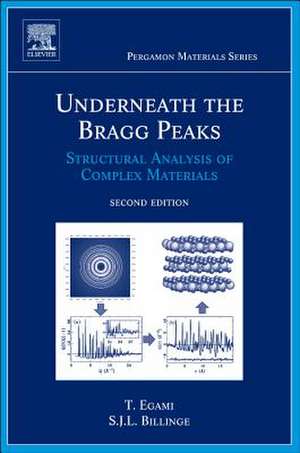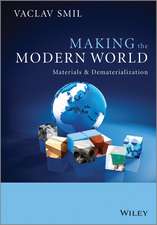Underneath the Bragg Peaks: Structural Analysis of Complex Materials
Autor Takeshi Egami, Simon J.L. Billingeen Limba Engleză Hardback – 22 noi 2012
Takeshi Egami received the 2003 Eugene Bertram Warren Diffraction Physics Award for the work described in the book.
The authors received 2010 J. D. Hanawalt Award from the International Union of Crystallography largely based on the success of this book.
- Introduces a unique method to study the atomic structure of nanomaterials
- Lays out the basic theory and methods of this important emerging technique
- The first edition is considered the seminal text on the subject
Preț: 773.52 lei
Preț vechi: 1009.62 lei
-23% Nou
Puncte Express: 1160
Preț estimativ în valută:
148.03€ • 160.74$ • 124.35£
148.03€ • 160.74$ • 124.35£
Carte tipărită la comandă
Livrare economică 15-29 aprilie
Preluare comenzi: 021 569.72.76
Specificații
ISBN-13: 9780080971339
ISBN-10: 0080971334
Pagini: 422
Ilustrații: Illustrations
Dimensiuni: 152 x 229 x 30 mm
Greutate: 0.79 kg
Ediția:Revised
Editura: ELSEVIER SCIENCE
ISBN-10: 0080971334
Pagini: 422
Ilustrații: Illustrations
Dimensiuni: 152 x 229 x 30 mm
Greutate: 0.79 kg
Ediția:Revised
Editura: ELSEVIER SCIENCE
Public țintă
Graduate students and postdoctoral fellows, as well as experienced researchers in solid state chemistry or physics, earth science, materials science and engineering and biochemistry working in the field of nanostructured materialsCuprins
1. Structure of complex materials
2. Crystallographic analysis of complex materials
3. The method of total scattering and atomic pair distribution function analysis
4. Total scattering experiments
5. Data collection and analysis
6. Extracting structural information from the PDF
7. Dynamics of the local structure
8. Structure of well-ordered crystals
9. Defects, nanocrystalline and crystallographically challenged materials
10. Local structure of systems with competing interactions
11. Phase transitions
12. The structure of anisotropic glasses
13. Concluding remarks
2. Crystallographic analysis of complex materials
3. The method of total scattering and atomic pair distribution function analysis
4. Total scattering experiments
5. Data collection and analysis
6. Extracting structural information from the PDF
7. Dynamics of the local structure
8. Structure of well-ordered crystals
9. Defects, nanocrystalline and crystallographically challenged materials
10. Local structure of systems with competing interactions
11. Phase transitions
12. The structure of anisotropic glasses
13. Concluding remarks
Recenzii
"Egami…and Billings…have updated this second edition on nanostructures substantially, using new materials drawn from the past ten years. They begin with general remarks on the structure of complex materials, then go on to examine crystallographic analysis of complex materials, the method of total scattering and pair distribution function (PDF) analysis, total scattering experiments, data collection analysis, exacting structural information on the PDF,…" --Reference and Research Book News, December 2013
Praise for the first edition:
"Egami and Billinge are experts in the application of PDF analysis and their writing is both clear and insightful. The organisation of the book is also excellent, with illuminating examples provided throughout. ...If you have an interest in atomic structure of materials, and local structural details in particular, PDF methods can be profoundly useful. I would heartily recommend this book as a starting point if you are considering using PDF analysis in your own work. For more experienced practitioners, this text is a useful reference." --Materials Today
Praise for the first edition:
"Egami and Billinge are experts in the application of PDF analysis and their writing is both clear and insightful. The organisation of the book is also excellent, with illuminating examples provided throughout. ...If you have an interest in atomic structure of materials, and local structural details in particular, PDF methods can be profoundly useful. I would heartily recommend this book as a starting point if you are considering using PDF analysis in your own work. For more experienced practitioners, this text is a useful reference." --Materials Today










